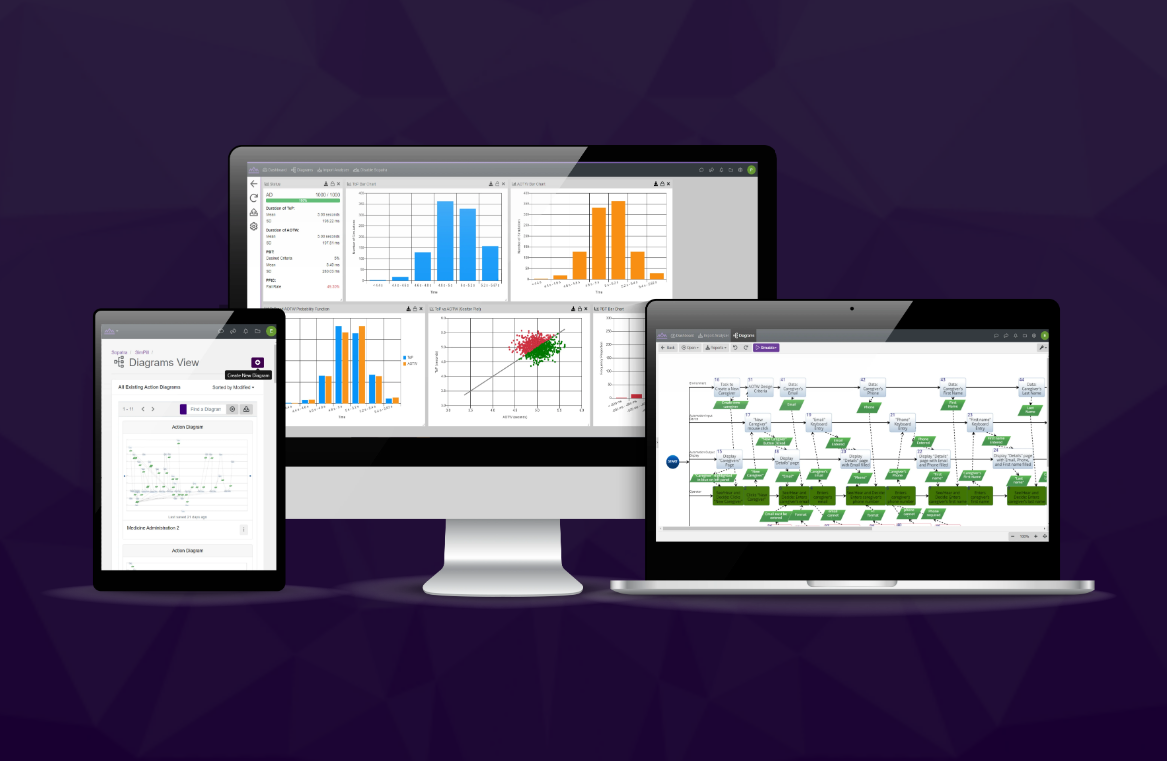
The Ultimate Guide to SOPs
The Digital Development and Analysis of Standard Operating Procedures (SOPs)

What are SOPs?
Standard Operating Procedures (SOPs) are step-by-step instructions or a process document of business processes, establishing a routine. SOPs are crucial for guiding operators to achieve desired outcomes. SOPs answer important questions such as:
- What should this accomplish?
- Each operator action is executed in a sequence.
- When (under what conditions)?
- Who is responsible for each step?
- How is each step performed?
- How to confirm the performance of the step?
Traditional SOP revision processes often lack operator involvement resulting in missing information and potential errors. The absence of a formal review and revision process for SOPs contributes to the increase of misinterpretation among operators.
This can lead to a knowledge gap, causing operators to struggle to understand the purpose behind certain steps. This leads to performance issues or errors. Without operator input, SOPs may also fail to capture real-world challenges that operators face during their day-to-day tasks. Additional problems include:
- Missing imperative steps in the SOPs due to automatic level of consciousness.
- What must be done is specified, but not when.
- Information required to perform the next step is not available.
- Race conditions – information not available in a timely manner.
- Cannot complete the procedure in time (i.e., before a hazardous event).
- Learning procedures can be difficult due to user-interface cues.
- Poor procedural training.
- No procedure for the scenario.
- Procedures across System-of-Systems are not compatible.
Sopatra, a digital assistance tool, addresses these issues and creates procedures that involve operators in the SOP revision process. It also uses a model-based approach and natural language processing (NLP) to reduce errors within complex systems.
Research and development of procedure representation language (PRL) breaks down each procedure step into perceptual, cognitive, and motor models. This aids natural language processing (NLP) and ensures standardized SOP formats based on human cognitive behavior. Decomposing PRL further will include human-machine interaction (HMI) when defining SOP structure with extended PRL (e-PRL).
These SOP steps have the following components:
- Trigger (Perceptual)
- Decision (Cognitive)
- Action (Motor)
- Waiting/Time (Perceptual)
- Verification (Perceptual)


Sopatra utilizes a standardized format to group components into various types of SOP steps:
- Action-Only
- Decision-Action
- Action with Waiting and Verification
- Decision-Action with Waiting and Verification
This format ensures that SOPs align with the operators’ cognitive processes in real-world scenarios. This includes the aviation industry’s need to enhance safety. Potential areas are:
NASA Applications
- Mission Control
- Launch Procedures
- Extravehicular Activities (EVA) procedures
- Space & Aircraft Maintenance Procedures
- Medical Procedures
Other organizations that have expressed interest in digital assistants
- Swiss International Air Lines
- Southwest Airlines
- United Airlines
- Boeing Commercial Aircraft Group (BCAG)
- Honeywell Technology Center
- Rockwell Collins
- U.S. Navy- Strategic Warfare Systems
Create Your SOPs
A methodology and digital tool are essential to avoid previous mistakes and meet the needs of high-stakes companies and projects. A methodology and digital tool does this by involving operators while writing the SOP and revising. Sopatra follows the three key goals for the SOP creation process utilizing model-based systems engineering (MBSE) activities:
- Digitizing SOPs in a database.
- Modeling, Simulating, and Analyzing SOPs.
- Verifying and validating each SOP as intended.
By performing these steps, Sopatra elevates the effectiveness of SOPs.

Digitizing SOPs
Improve SOPs by digitizing and importing into a database using NLP rules to consider:
- Actors
- Actions for Operators
- Actions resulting from cues from:
- Output Displays
- Environment
- Input Devices
NLP, particularly the Extended Procedural Representative Language (e-PRL), can enhance the conversion of textual documents into a structured database. The process involves importing SOP documents and parsing them using NLP algorithms. Then it creates entities and relationships in the database for automatic diagram generation.

To facilitate analysis, it labels and associates e-PRL elements with procedure entities. The root entity is labeled as “Procedure,” top and mid-level steps as “Steps,” and bottom-level steps as “Manual Instruction.”

Modeling SOPs
Models will identify e-PRL elements automatically. e-PRL’s canonical structure assists the NLP algorithm in accurately identifying the operator’s cognitive behavior. Annotations will aid in recognizing patterns & classifying e-PRL elements. e-PRL will provide a standardized format for creating the models.
e-PRL elements of Trigger, Decide, and Action assist with:
- Providing context & additional information for the operator.
- Reducing operator errors.
- Performing tasks effectively.
e-PRL elements of Waiting and Verification will assist with:
- Providing an understanding of the conditions to proceed to the next procedure.
- Reducing operator delays.
After generating the process model, view and change it to ensure it’s correct. The process model presents itself in a hierarchical structure similar to the imported textual SOP. Time Distributions can add to Procedure entities to simulate the operator’s performance.
Analyzing SOPs
The current SOP development and revision process overlooks the operator’s performance, which can result in inconsistencies and inaccuracies. Including operator performance into the SOP revision process results in several benefits, including consistency, accuracy, and training effectiveness.
Using Time metrics aid in providing data on the operator’s performance. These time metrics are:
- Allowable Operational Time Window (AOTW): Must complete the SOP in this time to avoid any hazards.
- Time of Procedure (ToP): Time it takes to complete the procedure.
- Procedure Buffer Time (PBT): The difference between AOTW & ToP.
- Value < 0, then the Procedure is not feasible.
The operator will need to input time distribution data when feasible. These time metrics will provide a high-level view to find the operator’s performance gaps.

Monte Carlo simulation will employ to evaluate the operator’s performance in the SOP. This allows for a comprehensive analysis of factors contributing to both good and poor performance. The e-PRL step structure, aligned with human-machine interaction (HMI), offers a standardized framework for different step types. This facilitates efficient information retrieval and reduces confusion.

Each e-PRL element correlates with an HMI element to provide an e-PRL step structure for each step type.
Heuristics will provide operators with feedback. Each heuristic will determine if the model follows the proper structure between HMI & e-PRL elements. This analysis will allow operators to:
- Identify proper relationships following the e-PRL format.
- Access feedback to locate and fix gaps.
- View data analytics of SOP structure based on e-PRL.
V&V SOPs
The e-PRL SOP steps encompass various types including:
- Action-ONLY Steps
- Decision-Action Steps
- Action w/ Waiting and Verification Steps
- Decision-Action w/ Waiting & Verification Steps
Each SOP step type follows a specific template that formats the syntax and language of e-PRL elements. This structured output aims to assist operators in executing concise and coherent procedure steps, while also providing analytics for future revision.
Verification and validation play a crucial role in this process. SOP revisions undergo thorough verification and validation to ensure accurate and relevant content. The results of this process drive adjustments and ongoing monitoring of procedures. Revisions aim to maintain consistency, prevent disruption, and minimize confusion within the workflow.
The current model will transform into an operation suite, serving as a text-based checklist for operators. Within the suite, the operator can provide inputs related to performance, notes, and completion steps.
The operation suite center serves as a hub for operators to execute and track SOP performance. It offers multiple run tracking in a unified view, real-time monitoring of SOP performance data, and areas for improvement. This ensures correct and consistent SOP adherence.
The operation suite center acts as a central repository for SOPs and associated data. This facilitates the management and analysis of SOP performance data.
Generating SOPs
After approval and testing, the operator will receive two documents:
- The finalized SOP Document containing the revised procedures.
- The SOP Data Analytics Document containing the data on operator performance & procedure structure.
This process provides data and feedback on revisions. It makes the reader aware of changes within the documented procedure and sets a process for ongoing review and improvement.


Sopatra, a digital assistant tool, actively involves operators in the revision process of Standard Operating Procedures (SOPs). This bridges the gap between SOPs and real-world operational environments.
It converts text to diagrams, conducts simulations, and provides visual accessibility to procedure information. Sopatra breaks down steps into components allowing for rearrangement and modification as needed. It identifies potential errors and areas for improvement, testing the impacts of modification.
This enhances the usability, efficiency, and alignment of SOPs with operator needs, resulting in improved performance, safety, and operational efficiency. Sopatra’s continuous improvement and operator input make it a valuable digital assistance tool for SOP management in industries.
Optimize Your SOPs Today
Sign Up for Sopatra
Model and verify your Standard Operating Procedures rapidly with Sopatra, your digital assistant. Get more reliable SOPs, completely free.
Sign Up Now


DESIGNING & ANALYZING STANDARD OPERATING PROCEDURES (SOPS)
This book describes how to build models of SOPs using model-based systems engineering. Learn how to evaluate the SOPs using heuristics and simulation. Start designing better standard operating procedures today.
The author, Dr. Lance Sherry, is the Director of the Center for Air Transportation Systems Research at George Mason University.




